
The Phasianidae are a family of heavy, ground-living birds, which includes pheasants, partridges, junglefowl, chickens, turkeys, Old World quail, and peafowl. The family includes many of the most popular gamebirds. The family is a large one and includes 185 species divided into 54 genera. It was formerly broken up into two subfamilies, the Phasianinae and the Perdicinae. However, this treatment is now known to be paraphyletic and polyphyletic, respectively, and more recent evidence supports breaking it up into two subfamilies: Rollulinae and Phasianinae, with the latter containing multiple tribes within two clades. The New World quail (Odontophoridae) and guineafowl (Numididae) were formerly sometimes included in this family, but are now typically placed in families of their own; conversely, grouse and turkeys, formerly often treated as distinct families, are now known to be deeply nested within Phasianidae, so they are now included in the present family.

The blood pheasant or blood partridge is the only species in genus Ithaginis of the pheasant family. It is a relatively small, short-tailed pheasant that is widespread and is fairly common in eastern Himalayas, ranging across India, Nepal, Bhutan, China, and northern Myanmar. Since the trend of the population appears to be slowly decreasing, the species has been evaluated as of least concern on the IUCN Red List in 2009.

The Tibetan sandgrouse is a large bird in the sandgrouse family. The genus name Syrrhaptes is from Ancient Greek surrhaptos, "sewn together" and tibetanus is from the type locality, Tibet.
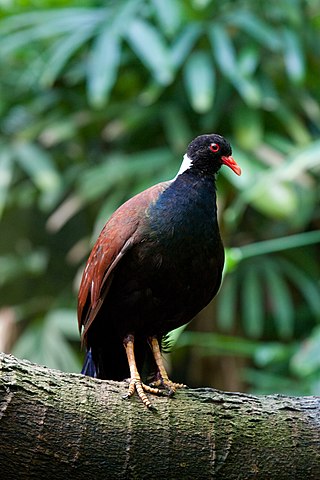
The pheasant pigeon is a species of large terrestrial pigeon. It is the only species of the monotypic genus Otidiphaps. The pheasant pigeon is found in the primary rainforests of New Guinea and nearby islands. It ranges primarily over hilly and lower mountain areas, but can also be found in lowlands.
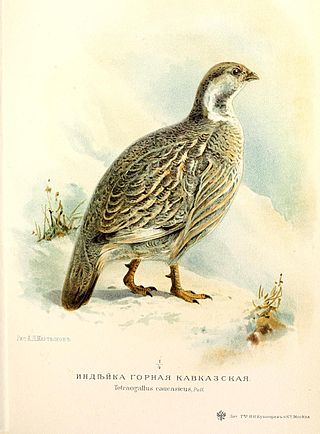
The Caucasian snowcock is a snowcock in the pheasant family Phasianidae of the order Galliformes, gallinaceous birds.
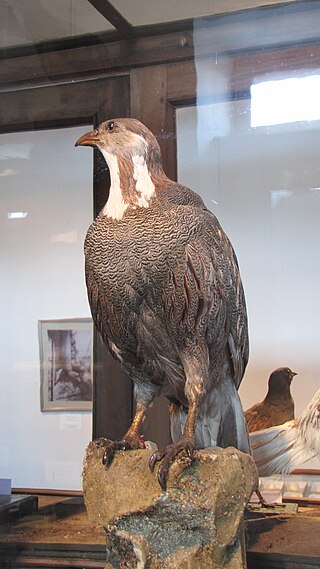
The Caspian snowcock is a snowcock in the pheasant family Phasianidae of the order Galliformes, gallinaceous birds.
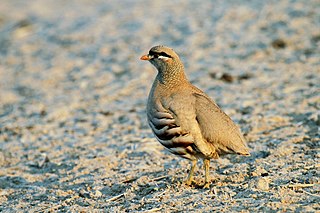
The see-see partridge is a gamebird in the pheasant family Phasianidae of the order Galliformes, gallinaceous birds.
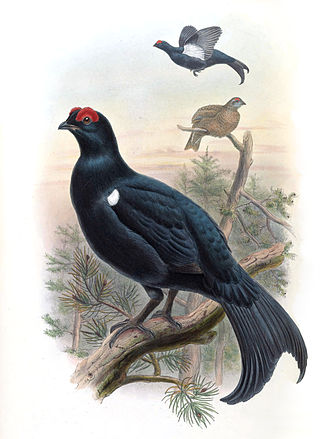
The Caucasian grouse or Caucasian black grouse is a large bird in the grouse family. It is closely related to the black grouse.

Salvadori's pheasant is a landfowl bird of genus Lophura, native to Indonesia. It is found in the mountain rainforests of Sumatra. Thus it is also known as the Sumatran pheasant. The Hoogerwerf's pheasant is usually thought to be a subspecies. This bird was first described in 1879 by the Italian ornithologist Tommaso Salvadori. The species name inornata means "without ornament".

The spotted wood quail is a small ground-dwelling bird in the New World quail family. It is a resident breeder in the mountains of Central America from southern Mexico to western Panama.
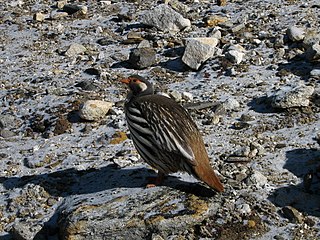
The Tibetan snowcock is a bird in the pheasant family Phasianidae of the order Galliformes, gallinaceous birds. This species is found in high-altitude regions of the Western Himalayas and the Tibetan Plateau, where it overlaps in part with the larger Himalayan snowcock. The head is greyish and there is a white crescent patch behind the eye and underside is white with black stripes. In flight the secondaries show a broad white trailing edge.

The Chinese monal or Chinese impeyan is a pheasant. This monal is restricted to mountains of central China. The plumage is highly iridescent. The male has a large drooping purple crest, a metallic green head, blue bare skin around the eyes, a reddish gold mantle, bluish green feathers and black underparts. The female is dark brown with white on its throat.

The Himalayan snowcock is a snowcock in the pheasant family Phasianidae found across the Himalayan ranges and parts of the adjoining Pamir range of Asia. It is found on alpine pastures and on steep rocky cliffs where they will dive down the hill slopes to escape. It overlaps with the slightly smaller Tibetan snowcock in parts of its wide range. The populations from different areas show variations in the colouration and about five subspecies have been designated. They were introduced in the mountains of Nevada in the United States in the 1960s and a wild population has established in the Ruby Mountains.

The chestnut-bellied partridge also known as chestnut-bellied hill-partridge or Javan hill-partridge is a small, up to 28 cm long, partridge with a rufous crown and nape, red legs, grey breast, brown wings, red facial skin, and a black mask, throat and bill. It has a rufous belly with white on the middle. The sexes are similar. The young has a whitish face and a reddish brown bill.

Philby's partridge or Philby's rock partridge, is a relative of the chukar, red-legged partridge and barbary partridges and is native to southwestern Saudi Arabia and northern Yemen. Although similar in appearance to other Alectoris species, Philby's partridge can be distinguished by its black cheeks and throat. Although not currently listed as an endangered species, the Arab Spring and destruction of its fragile habitat in the tribal areas of Northern Yemen had led to concerns about the survival of this species. The name commemorates the British explorer St John Philby.

The Hainan partridge is a species of bird in the family Phasianidae. It is endemic to Hainan Island, China. Its natural habitats are primary evergreen forests. It is threatened by habitat loss and has been assessed as a vulnerable species.

The white-necklaced partridge, also known as the collared partridge or Rickett's hill-partridge, is a species of bird in the family Phasianidae. It is endemic to southeastern China. It is threatened by habitat loss and hunting, and the IUCN has assessed it as near-threatened.

Bamboo partridges, sometimes called ridge partridges, are medium-sized non-migratory birds of the genus Bambusicola in the family Phasianidae.They have a wide native distribution throughout Asia. They were formerly grouped in the Perdicinae subfamily of the Phasianidae. However, molecular research suggests that partridges are not a distinct taxon within the family Phasianidae, but that some species are closer to the pheasants, while others are closer to the junglefowl. Phylogenetic evidence supports the bamboo partridges as being the sister genus to the junglefowl.

The Altai snowcock is a species of bird in the family Phasianidae. It is found in western Mongolia and adjacent areas of China, Kazakhstan and Russia. Its natural habitat is boreal forests.

Perdicinae is a polyphyletic former subfamily of birds in the pheasant family, Phasianidae, regrouping the partridges, Old World quails, and francolins. Although this subfamily was considered monophyletic and separated from the pheasants, tragopans, junglefowls, and peafowls (Phasianinae) till the early 1990s, molecular phylogenies have shown that these two subfamilies actually constitute only one lineage. For example, some partridges are more closely affiliated to pheasants, whereas Old World quails and partridges from the Alectoris genus are closer to junglefowls. Due to this, the subfamily Perdicinae is no longer recognized by the International Ornithological Congress, with the species being split among 3 subfamilies.





























